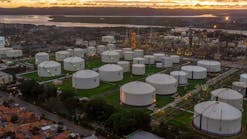Korean petrochemical complex to boost operator’s competitiveness
Hyundai Chemical Co. Ltd., a joint venture of Hyundai Oilbank Co. Ltd. and Lotte Chemical Corp., has commissioned its long-planned heavy-feed petrochemical complex (HPC) at the JV’s existing Daesan complex in Seosan, Chungcheongnam-do Province, South Korea, 130 km southwest of Seoul.
Located within the fence line of Hyundai Oilbank’s 520,000-b/d Daesan refining complex, the $2.5-billion HPC involved construction of a grassroots 850,000-tonne/year (tpy) ethylene steam cracker equipped with flexibility to produce low-density polyethylene (LDPE), high-density polyethylene (HDPE), and propylene from a mix of feedstocks including naphtha, treated deasphalted (heavy) oil, and refinery offgas it receives from the Daesan refinery.
Alongside presenting an overview of the project, this article discusses Shell Catalysts & Technologies’ (SC&T) participation in readying the HPC for startup.
JV background
Established in May 2014, Hyundai Chemical is South Korea’s first JV between petroleum and petrochemical companies, forming part of partners Hyundai Oilbank (60%) and Lotte Chemical’s (40%) strategies to strengthen cooperation in a way that would create business opportunities and ensure long-term sustainability and competitiveness for both companies.
Hyundai Chemical, which began commercial operations in November 2016 with startup of its first Daesan chemical plant, uses a feedstock of condensate and naphtha produced by units at Hyundai Oilbank’s adjacent refinery to produce 1.35 million tpy of mixed xylenes (Fig. 1).
Following upgrades completed in 2019, Hyundai Chemical can also process 170,000 b/d of condensate to produce 3.5 million tpy of petrochemicals that, in addition to mixed xylenes, includes light naphtha, and about 26 million bbl/year of finished petroleum products including diesel and jet fuel, according to Hyundai Oilbank’s latest annual report to investors.
HPC overview
Officially approved for development by Hyundai Oilbank and Lotte Chemical in May 2018, Hyundai Chemical’s HPC specifically was designed to expand its use of by-products from units at the adjacent refinery for production of petrochemicals as part of the partners’ plan to boost the JV’s global competitiveness, Hyundai Oilbank said. Siting the HPC on a 500-sq m tract of dedicated land inside the fence line of the Daesan refining complex ensures more than 60% of the new petrochemical complex’s feedstock would consist of refinery by-products such as LPG, refinery offgas, and desulfurized heavy oil (Fig. 2).
Less expensive than naphtha and produced on site, use of the proximal feedstocks is intended to help boost Hyundai Chemical’s profitability and competitiveness, the partners said upon announcing final investment decision on the project.
In November 2019, Hyundai Chemical let a contract to Daelim Industrial Co. Ltd. to deliver engineering, procurement, and construction services for the HPC, which—upon award of the contract—Daelim said was to include the following production capacities:
- Ethylene; 750,000 tpy.
- LDPE; 300,000 tpy.
- HDPE; 300,000 tpy.
- Polypropylene; 250,000 tpy.
By early 2021, however, Hyundai Oilbank confirmed a revision to previously announced planned production capacities. Instead, the HPC is now configured to produce:
- 850,000 tpy of ethylene.
- 850,000 tpy of LDPE, HDPE (combined).
- 500,000 tpy of polypropylene.
HPC startup, environmental benefits
In February 2022, SC&T—which delivered its proprietary C2 Front-End (FE) selective hydrogenation catalyst for the new complex’s core unit—confirmed in a news release that Hyundai Chemicals achieved a safe and expedited startup of the HPC with minimal flaring in December 2021.
Use of the C2 FE catalyst—which enables ethylene producers to achieve higher yields due to its enhanced ethylene selectivity—allowed the operator to reach early stabilization of the ethylene plant, according to Ha Chang-Soo, Hyundai Chemical’s commissioning team leader for the HPC.
While neither the JV partners nor Hyundai Chemical directly has referred to the newly commissioned HPC as an element of the companies’ collective transition to a net-zero carbon future, SC&T said its role in the startup process as well as the minimal flaring enabled by use of the C2 FE catalyst does come as part of Hyundai Chemical’s journey in the energy transition and decarbonization.

Robert Brelsford | Downstream Editor
Robert Brelsford joined Oil & Gas Journal in October 2013 as downstream technology editor after 8 years as a crude oil price and news reporter on spot crude transactions at the US Gulf Coast, West Coast, Canadian, and Latin American markets. He holds a BA (2000) in English from Rice University and an MS (2003) in education and social policy from Northwestern University.

